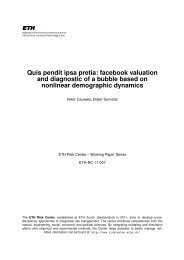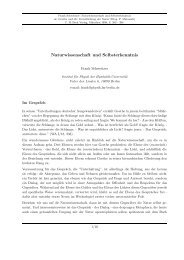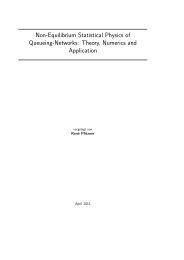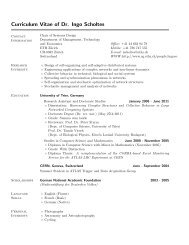Using Laboratory Experiments to Study Law and Crime - Chair of ...
Using Laboratory Experiments to Study Law and Crime - Chair of ...
Using Laboratory Experiments to Study Law and Crime - Chair of ...
You also want an ePaper? Increase the reach of your titles
YUMPU automatically turns print PDFs into web optimized ePapers that Google loves.
ARTIFICIALITY AND SIMPLICITYWhile both labora<strong>to</strong>ry <strong>and</strong> field experiments share a reliance on r<strong>and</strong>om assignment,labora<strong>to</strong>ry experiments are unique in their artificiality. Theories are simplifications <strong>of</strong> reality(Hechter <strong>and</strong> Horne, 2009). Thus experiments that are designed <strong>to</strong> test theory will be simplerthan a field setting. One <strong>of</strong> the challenges <strong>of</strong> testing theories in the field is that many things arecovarying simultaneously. The world is complicated. It can be difficult therefore <strong>to</strong> study theparticular processes identified by a theory. In survey studies we deal with this difficulty bystatistically controlling for possibly relevant fac<strong>to</strong>rs. By contrast, in the labora<strong>to</strong>ry, because wecreate artificial settings, we can eliminate extraneous fac<strong>to</strong>rs by design.The fact that labora<strong>to</strong>ry experiments control for fac<strong>to</strong>rs extraneous <strong>to</strong> the theory bydesign rather than through statistics means that they do not include as many variables as we areused <strong>to</strong> seeing in survey analyses. When using survey data we try <strong>to</strong> include all <strong>of</strong> the potentiallyrelevant variables in order <strong>to</strong> maximize the amount <strong>of</strong> variation in the outcome that we canexplain. By contrast, in a labora<strong>to</strong>ry experiment, we focus on only a few causal fac<strong>to</strong>rs in order<strong>to</strong> explain why they have an effect – that is, in order <strong>to</strong> underst<strong>and</strong> the mechanisms at work. Thusexperiments will be as simple as the theories they are designed <strong>to</strong> test (see Willer <strong>and</strong> Walker2007; Helbing <strong>and</strong> Yu 2010). If the empirical implications <strong>of</strong> the theory are supported ordisconfirmed in the labora<strong>to</strong>ry, then the theory has been appropriately tested. Such a test doesnot tell us about all <strong>of</strong> the fac<strong>to</strong>rs that might affect an outcome, but rather increases ourunderst<strong>and</strong>ing <strong>of</strong> the mechanisms linking a small number <strong>of</strong> causal fac<strong>to</strong>rs <strong>to</strong> that outcome.The goal <strong>of</strong> underst<strong>and</strong>ing mechanisms might even lead us <strong>to</strong> create situations that do notexist naturally in the world (Webster <strong>and</strong> Kervin, 1971). For example, we know thatneighborhoods with higher levels <strong>of</strong> mobility have higher levels <strong>of</strong> crime. We also know thatneighborhoods with higher proportions <strong>of</strong> renters relative <strong>to</strong> home owners have higher rates <strong>of</strong>crime. Suppose that we identify two possible mechanisms that may be operating – financialinvestment in a neighborhood or social attachment. How would we know whether one or both <strong>of</strong>these mechanisms is operating? It would be difficult <strong>to</strong> disentangle these in the field (where5







